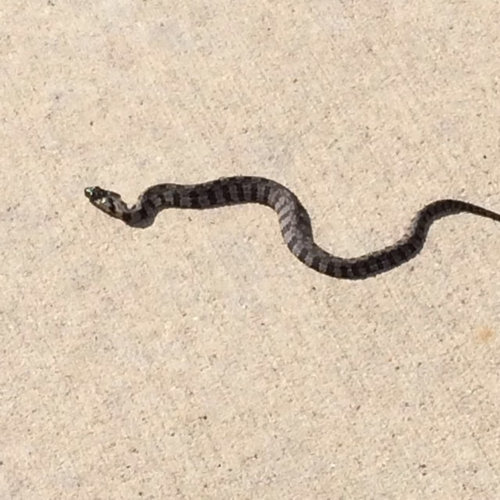Please id this snake
chitralekha
8 years ago
Featured Answer
Comments (9)
chitralekha
8 years agoRelated Discussions
Snake Road photos - snake id again please
Comments (6)Nice Pictures! I can answer your question. That black snake is a black rat snake. Was that midland water snake (subspecies of the northern water snake) found at LaRue Road. I have never found a midland water there before. In fact I don't think I know anyone who has seen one there either. I'm sure they have a good population there, but it surprises me that you saw one. They generally inhabit lakes, creeks and rivers. One doesn't usually see a midland or northern water snake in cypress swamp. I have seen them up north in oxbow lakes. I did see a midland water snake at Mingo swamp in a ditch, but that is far as my northern water snake experience goes. Nice find. Ryan...See MoreSnake ID
Comments (2)Harmless Diamondbacked Watersnake (Nerodia rhombifer). Looks like it just had a big meal. Cottonmouths are not common in Central Texas, depending what you call "central" Texas. They are there, but the harmless watersnakes significantly outnumber them. I have spent a lot of time working with snakes in the Central TX area (particularly Gillespie, Llano, Bexar, Kendall, Comal, Bandera, Kerr, and Real counties) and have seen very few Cottonmouths and they seem to be restricted to a few places. Most local people felt that they were much more common than they actually were. When I lived in San Angelo (which is actually more centrally located than Austin or San Antonio, but considered "west" Texas by most), Cottonmouths were restricted to a few streams and largely absent from most bigger bodies of water....See MorePlease ID snake. TY
Comments (2)Cottonmouth / Water Moccasin (Agkistrodon piscivorus)...See MoreCan you ID this snake, please?
Comments (1)Eastern Milksnake. (Harmless)...See Morechitralekha
8 years agosylviatexas1
8 years agoUser
7 years agolast modified: 7 years agoRenee Texas
7 years agoloreleicomal
7 years agoTodd C
7 years ago
Related Stories

DENS AND LIBRARIESRoom of the Day: Princess the Snake Reigns in a Luxe Library
Sure, there are books. But in this library the custom snake habitat may be most worth checking out
Full Story
HOUSEPLANTSMother-in-Law's Tongue: Surprisingly Easy to Please
This low-maintenance, high-impact houseplant fits in with any design and can clear the air, too
Full Story
HOME OFFICESQuiet, Please! How to Cut Noise Pollution at Home
Leaf blowers, trucks or noisy neighbors driving you berserk? These sound-reduction strategies can help you hush things up
Full Story
BATHROOM DESIGNUpload of the Day: A Mini Fridge in the Master Bathroom? Yes, Please!
Talk about convenience. Better yet, get it yourself after being inspired by this Texas bath
Full Story
BEFORE AND AFTERSMore Room, Please: 5 Spectacularly Converted Garages
Design — and the desire for more space — turns humble garages into gracious living rooms
Full Story
SUMMER GARDENINGHouzz Call: Please Show Us Your Summer Garden!
Share pictures of your home and yard this summer — we’d love to feature them in an upcoming story
Full Story
DECORATING GUIDESPlease Touch: Texture Makes Rooms Spring to Life
Great design stimulates all the senses, including touch. Check out these great uses of texture, then let your fingers do the walking
Full Story
TILEMoor Tile, Please!
Add an exotic touch with Moroccan tiles in everything from intricate patterns and rich colors to subtle, luminous neutrals
Full Story
FLOORSChecks, Please! 13 Choices for Checkered Floors
Checkerboard Patterns Go From Casual to Ritzy, From Marble to Grass
Full Story





briaustex